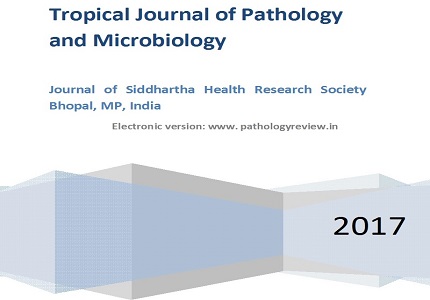Increasing antibiotic resistance amongst Uropathogenic E. coli isolated from inpatients with symptomatic UTI - a three year study
Abstract
Introduction: Escherichia coli (E.coli) is one of the most common uropathogen worldwide. In the past few years, uropathogenic E.coli has become increasingly resistant to many drugs.
Materials and Methods: This prospective observational study was conducted from January 2014 to December 2016. Semiquantitative urine culture was done on blood agar and MacConkey agar using standard technique. Cultures showing a significant growth of 105 CFU/ml or more were further processed. Identification and analysis of antibiotic susceptibility patterns was done by VITEK®2 (bioMerieux, USA).
Results: A total of 674 E. coli samples were included in the final analysis. The isolates showed highest overall sensitivity to imipenem (75.82%) and nitrofurantoin (72.25%) whereas highest resistance was observed in case of amoxicillin-clavulinic acid (84.12%) and cephalosporins (71.96-83.23%), followed by ciprofloxacin (72.70%), amikacin (64.39%) and TMP-SMX (64.24%). Over three years duration, a trend of increasing resistance was observed in the case of cephalosporins, ciprofloxacin and trimethoprim-sulfamethoxazole (TMP-SMX). Percentage of MDR E.coli also increased over three years.
Conclusion: There is an increase in antibiotic resistance amongst uropathogenic Escherichia coli over the past three years. Routine surveillance of resistance patterns should continue in the hospitals and antibiotic policy should be constantly updated. Judicious use of antibiotics is the need of the hour.
Downloads
References
2. Foxman B. Recurring urinary tract infection: incidence and risk factors. Am J Public Health. 1990 Mar;80(3):331-3. [PubMed]
3. Bours PHA, Polak R, Hoepelman AIM, Delgado E, Jarquin A, Matute J. Increasing resistance in community-acquired urinary tract infections in Latin America, five years after the implementation of national therapeutic guidelines. Int J Infect Dis.2010 Sep;14(9):e770-4.doi: 10.1016/j.ijid.2010.02.2264.
4. Gupta K, Scholes D, Stamm WE. Increasing prevalence of antimicrobial resistance among uropathogens causing acute uncomplicated cystitis in women. JAMA 1999;281(8):736-738. doi:10.1001/jama.281.8.736. 281:736-8.
5. Mandal J, Acharya NS, Buddhapriya D, Parija SC. Antibiotic resistance pattern among common bacterial uropathogens with a special reference to ciprofloxacin resistant Escherichia coli. Indian J Med Res. 2012 Nov; 136(5): 842–849.
6. Akram M, Shahid M, Khan AU. Etiology and antibiotic resistance patterns of community acquired urinary tract infections in JNMC hospital Aligrah, India. Ann Clin Microbiol Antimicrob. 2007 Mar 23;6:4. DOI:10.1186/1476-0711-6-4.
7. Alós JI, Serrano MG, Gomez-Garces JL, Perianes J.. Antibiotic resistance of Escherichia coli from community-acquired urinary tract infections in relation to demographic and clinical data. Clin Microbiol Infect. 2005;11(3):199-203. DOI:10.1111/j.1469-0691.2004.01057.x. [PubMed]
8. Timothy OO, Olusesan FJ, Adesola BO, Temitayo AA, David FO, Ige OO. Antibiotic resistance pattern of bacterial isolates from cases of urinary tract infections among hospitalized and out-patients at a tertiary health facility in South Western Nigeria. Ann trop med pub health. 2014;7(2):130-5. http://www.atmph.org/text.asp?2014/7/2/130/146403
9. Karaca Y, Coplu N, Gozalan A, Oncul O, Citil BE, Esen B. Co-trimoxazole and quinolone resistance in Escherichia coli isolated from urinary tract infections over the last 10 years. International J Antimicrob Agents. 2005;26(1):75-7. doi: 10.1016/j.ijantimicag.2005.03.012.
10. Anand N, Asthana AK, Madan M, Vats AD. Antibiotic resistance pattern in E.coli causing community acquired Urinary tract infections. Journal of Advance Researches in Biological Sciences. 2014;6(3&4):209-12.
11. Goettsch W, van Pelt W, Nagelkerke N, Hendrix MG, Buiting AG, Petit PL, Sabbe LJ, van Griethuysen AJ, de Neeling AJ. Increasing resistance to fluoroquinolones in escherichia coli from urinary tract infections in the netherlands. J Antimicrob Chemother. 2000 Aug;46(2):223-8.
12. Niranjan V, Malini A. Antimicrobial resistance pattern in Escherichia coli causing urinary tract infection among inpatients. Indian J Med Res. 2014;139(6):945-8. http://icmr.nic.in/ijmr/2014/june/0621.pdf
13. Sorlozano A, Jimenez-Pacheco A, Luna del castillo JD, Sampedro A, Martinez-Brocal A, Miranda-Casas C, Navarro-Marí JM, Gutiérrez-Fernández J. Evolution of the resistance to antibiotics of bacteria involved in urinary tract infections: A 7-year surveillance study. American J Inf Control.2014;42(10):1033 - 8. doi: 10.1016/j.ajic.2014.06.013.
14. Dehbanipour R, Rastaghi S, Sedighi M, Maleki N, Faghri J. High prevalence of multidrug-resistance uropathogenic Escherichia coli strains, Isfahan, Iran. J Nat Sci Biol Med. 2016;7(1):22-6. DOI: 10.4103/0976-9668.175020.
15. Ali I, Kumar N, Ahmed S, Dasti JI. Antibiotic Resistance in Uropathogenic E. Coli Strains Isolated from Non-Hospitalized Patients in Pakistan. J Clin Diagn Res. 2014;8(9):DC01-4. doi: 10.7860/JCDR/2014/7881.4813.
16. Shariff V A AR, Shenoy M S, Yadav T, M R. The antibiotic susceptibility patterns of uropathogenic Escherichia coli, with special reference to the fluoroquinolones. J Clin Diagn Res. 2013 Jun;7(6):1027-30. doi: 10.7860/JCDR/2013/4917.3038. Epub 2013 Jun 1.
17. van der Starre WE, van Nieuwkoop C, Paltansing S, van't Wout JW, Groeneveld GH, Becker MJ, Koster T, Wattel-Louis GH, Delfos NM, Ablij HC, Leyten EM, Blom JW, van Dissel JT. Risk factors for fluoroquinolone-resistant Escherichia coli in adults with community-onset febrile urinary tract infection. J Antimicrob Chemother. 2011 Mar;66(3):650-6. doi: 10.1093/jac/dkq465. Epub 2010 Dec 1.
18. Khawcharoenporn T, Vasoo S, Singh K. Urinary Tract Infections due to Multidrug-Resistant Enterobacteriaceae: Prevalence and Risk Factors in a Chicago Emergency Department. Emerg Med Int. 2013;2013:258517. doi: 10.1155/2013/258517. Epub 2013 Oct 31.
19. Killgore KM, March KL, Guglielmo BJ. Risk factors for community-acquired ciprofloxacin-resistant Escherichia coli urinary tract infection. Annals Pharmacother. 2004; 38:1148–52. DOI: 10.1345/aph.1D622.
20. Cohen-Nahum K, Saidel-Odes L, Riesenberg K, Schlaeffer F, Borer A. Urinary tract infections caused by multi-drug resistant Proteus mirabilis: Risk factors and clinical outcomes. Infection. 2010 Feb;38(1):41-6. doi: 10.1007/s15010-009-8460-5. Epub 2009 Dec 7.
21. Gupta K, Hooton TM, Naber KG, Wullt B, Colgan R, Miller LG, Moran GJ, Nicolle LE, Raz R, Schaeffer AJ, Soper DE. International Clinical Practice Guidelines for the Treatment of Acute Uncomplicated Cystitis and Pyelonephritis in Women: A 2010 Update by the Infectious Diseases Society of America and the European Society for Microbiology and Infectious Diseases. Clinical Infectious Diseases. 2011;52(5)103-120. https://doi.org/10.1093/cid/ciq257. [PubMed]
22. National Treatment guidelines for Antimicrobial use in Infectious Diseases. NCDC.2016.Version 1.0. http://pbhealth.gov.in/AMR_guideline7001495889.pdf



 OAI - Open Archives Initiative
OAI - Open Archives Initiative


